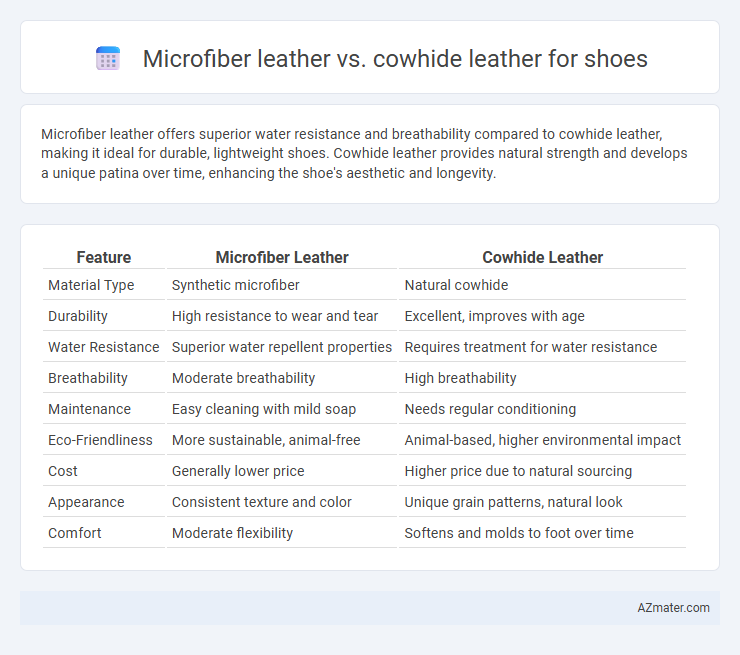Microfiber leather offers superior water resistance and breathability compared to cowhide leather, making it ideal for durable, lightweight shoes. Cowhide leather provides natural strength and develops a unique patina over time, enhancing the shoe's aesthetic and longevity.
Table of Comparison
| Feature | Microfiber Leather | Cowhide Leather |
|---|---|---|
| Material Type | Synthetic microfiber | Natural cowhide |
| Durability | High resistance to wear and tear | Excellent, improves with age |
| Water Resistance | Superior water repellent properties | Requires treatment for water resistance |
| Breathability | Moderate breathability | High breathability |
| Maintenance | Easy cleaning with mild soap | Needs regular conditioning |
| Eco-Friendliness | More sustainable, animal-free | Animal-based, higher environmental impact |
| Cost | Generally lower price | Higher price due to natural sourcing |
| Appearance | Consistent texture and color | Unique grain patterns, natural look |
| Comfort | Moderate flexibility | Softens and molds to foot over time |
Introduction to Microfiber Leather and Cowhide Leather
Microfiber leather, a synthetic material engineered from ultra-fine fibers, offers high durability, water resistance, and eco-friendliness, making it an innovative alternative to traditional materials. Cowhide leather, derived from cattle, is renowned for its natural breathability, robustness, and ability to develop a unique patina over time, reflecting authentic craftsmanship. Comparing these materials highlights microfiber leather's consistent performance and low maintenance versus cowhide leather's natural texture and long-lasting comfort in footwear.
Composition and Manufacturing Process
Microfiber leather for shoes is composed of a blend of polyurethane and ultra-fine polyester fibers, creating a synthetic material that mimics the texture and durability of natural leather while being lightweight and water-resistant. Cowhide leather is derived from the tanned hide of cows, utilizing a natural collagen fiber structure that offers breathability, strength, and aging characteristics unique to animal leather. The manufacturing process for microfiber leather involves extrusion and coating techniques to bond layers, whereas cowhide leather undergoes tanning, drying, and finishing stages that preserve its organic properties and enhance its durability for footwear applications.
Durability and Wear Resistance
Microfiber leather offers superior durability and wear resistance compared to traditional cowhide leather, with enhanced resistance to scratches and abrasions due to its synthetic composition. Cowhide leather, while naturally breathable and flexible, tends to develop creases and scuffs over time under rigorous use. Microfiber leather's tightly woven fibers and water-resistant properties extend shoe lifespan, making it a preferred choice for high-performance footwear.
Comfort and Breathability
Microfiber leather offers superior breathability due to its synthetic fiber structure, allowing better air circulation and moisture wicking compared to traditional cowhide leather. Cowhide leather, although durable and breathable, tends to retain heat and moisture, which can reduce overall comfort during extended wear. The lightweight nature of microfiber leather enhances flexibility and comfort, making it ideal for shoes designed for long-term use or active wear.
Appearance and Texture
Microfiber leather offers a consistent, smooth surface with a uniform grain that mimics high-quality cowhide leather, making it visually appealing and ideal for fashion-forward shoes. Cowhide leather features a natural grain with unique texture variations and slight imperfections that enhance the shoe's authenticity and character over time. The texture of microfiber leather is typically softer and more flexible, while cowhide leather provides a firmer, more durable feel that develops a rich patina with wear.
Environmental Impact and Sustainability
Microfiber leather offers a more sustainable alternative to cowhide leather by requiring less water and energy during production, significantly reducing carbon emissions. Cowhide leather involves animal husbandry, which contributes to deforestation, methane emissions, and high water consumption, impacting the environment negatively. Choosing microfiber leather for shoes supports lower ecological footprints and aligns with eco-friendly fashion trends.
Water Resistance and Maintenance
Microfiber leather offers superior water resistance compared to cowhide leather, making it ideal for wet conditions and reducing the risk of water damage. Cowhide leather requires regular conditioning and waterproof treatments to maintain its durability and prevent cracking from moisture exposure. Maintenance of microfiber leather is generally easier, involving simple cleaning with a damp cloth, whereas cowhide demands more intensive care to preserve its natural texture and longevity.
Cost and Affordability
Microfiber leather offers a cost-effective alternative to cowhide leather for shoes, with prices typically ranging 30-50% lower due to its synthetic manufacturing process. Cowhide leather, valued for its durability and natural texture, commands a higher price point reflecting its premium quality and longer lifespan. Budget-conscious consumers often prefer microfiber leather for affordable, stylish footwear without sacrificing appearance.
Suitability for Shoe Applications
Microfiber leather offers superior water resistance, breathability, and lightweight properties, making it highly suitable for casual and athletic shoe applications. Cowhide leather provides exceptional durability, natural flexibility, and a classic aesthetic, ideal for formal and high-end dress shoes. The choice between microfiber and cowhide leather depends on the desired balance between performance, maintenance, and style for specific shoe applications.
Final Comparison: Which is Better for Shoes?
Microfiber leather offers superior water resistance, lightweight flexibility, and enhanced breathability compared to cowhide leather, making it ideal for athletic and casual shoes. Cowhide leather excels in durability, natural breathability, and a classic aesthetic, preferred for formal and high-quality dress shoes. The choice depends on specific use cases: microfiber leather suits performance and maintenance ease, while cowhide leather provides longevity and timeless style.

Infographic: Microfiber leather vs Cowhide leather for Shoe
 azmater.com
azmater.com